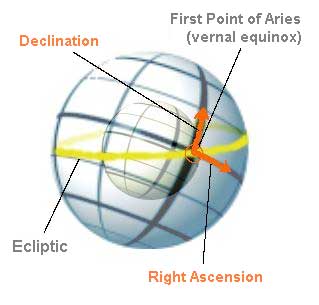|
In astronomy, declination (abbrev. dec or δ) is one of the two coordinates of the equatorial coordinate system, the other being either right ascension or hour angle. Dec is comparable to latitude, projected onto the celestial sphere, and is measured in degrees north and south of the celestial equator. Therefore, points north of the celestial equator have positive declinations, while those to the south have negative declinations. * An object on the celestial equator has a dec of 0°. * An object above the north pole has a dec of +90°. * An object above the south pole has a dec of −90°. The sign is customarily included even if it is positive. Any unit of angle can be used for declination, but it is often expressed in degrees, minutes, and seconds of arc. A celestial object that passes over zenith, has a declination equal to the observer's latitude, with northern latitudes yielding positive declinations. A pole star therefore has the declination +90° or -90°. Conversely, at northern latitudes φ > 0, celestial objects with a declination greater than 90° - φ, are always visible. Such stars are called circumpolar stars, while the phenomenon of a sun not setting is called midnight sun. If instead of measuring from and along the equator the angles are measured from and along the horizon, the angles are called azimuth and altitude (elevation). Stars Because a star lies in a nearly constant direction as viewed from earth, its declination is approximately constant from year to year. However, both the right ascension and declination do change gradually due to the effects of precession of the equinoxes and proper motion. Varying declination The declinations of all solar system objects change much more quickly than those of stars. Sun The declination of the Sun (δ) is the angle between the rays of the sun and the plane of the earth's equator. Since the angle between the earth axis and the plane of the earth orbit is nearly constant, δ varies with the seasons and its period is one year, that is the time needed by the earth to complete its revolution around the sun. When the projection of the earth axis on the plane of the earth orbit is on the same line linking the earth and the sun, the angle between the rays of the sun and the plane of the earth equator is maximum and its value is 23°27'. This happens at the solstices. Therefore δ = +23°27' at the northern hemisphere summer solstice and δ = -23°27' at the northern hemisphere winter solstice. Due to the changes in the tilt of the Earth's axis, the angle between the rays of the sun and the plane of the earth equator is slightly decreasing. When the projection of the earth axis on the plane of the earth orbit is perpendicular to the line linking the earth and the sun, the angle between the rays of the sun and the plane of the earth equator is null. This happens at the equinoxes. Therefore δ is 0° at the equinoxes. Since the eccentricity of the earth orbit is quite low, it can be approximated to a circle, and δ is approximately given by the following expression:
where cos operates on degrees; if cos operates on radians, 360° in the equation needs to be replaced with 2π and will still output δ in degree; N is Day of the Year, that is the number of days spent since January 1. An alternative form is given as:[1]
A more precise formula is given by:[2]
where
is the fractional year in radians. More accurate daily values from averaging the four years of a leap-year cycle are given in the Table of the Declination of the Sun. A diagram demonstrating how the Sun's path over the celestial sphere changes with the varying declination during the year, marking the Azimuths in °N where the sun rises and sets at summer and winter solstice at a place of 56°N latitude. A diagram demonstrating how the Sun's path over the celestial sphere changes with the varying declination during the year, marking the Azimuths in °N where the sun rises and sets at summer and winter solstice at a place of 56°N latitude.
A diagram demonstrating how the Sun's path over the celestial sphere changes with the varying declination during the year, marking the Azimuths in °N where the sun rises and sets at summer and winter solstice at a place of 56°N latitude. Moon The Moon also has an annual cycle, with maximum declination at northern hemisphere midwinter and minimum at midsummer. There is also an approximately 19 year long cycle, varying the maximum declination from +28°35' to +18°18' and the minimum from -18°18' to -28°35'. See also * right ascension, celestial coordinate system * geographic coordinates, ecliptic * Setting circles Declination is used in some contexts that rule out astronomical declination, to mean the same as magnetic declination. Declination is occasionally and erroneously used to refer to the linguistic term declension. References 1. ^ Solar Declination 2. ^ Spencer, J.W. 1971: Fourier series representation of the position of the Sun. Search, 2(5), 172. Links * Table of the Declination of the Sun: Mean Value for the Four Years of a Leap-Year Cycle Retrieved from "http://en.wikipedia.org/"

|
|
||||||||||

